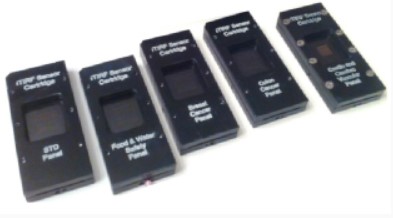Development Tools: Handheld i-Diagnostics (Prototype) and Cartridge Blanks
 In the framework of Open Innovation Business Model, TIRF Labs offers the prototype of the handheld i-Diagnostics device with cartridge blanks and sample preparation modules as development tools. This group of products is useful for the final steps of test development, including the interfacing of existing fluorescence bioassays with the i-Diagnostics platform.
In the framework of Open Innovation Business Model, TIRF Labs offers the prototype of the handheld i-Diagnostics device with cartridge blanks and sample preparation modules as development tools. This group of products is useful for the final steps of test development, including the interfacing of existing fluorescence bioassays with the i-Diagnostics platform.
If an existing set of assays and sample preparation procedures meet the criteria for fluorescence detection, assay immobilization and sample prep, early development stages can be omitted and the final development tasks can be performed with the handheld i-Diagnostics prototype and cartridge blanks (see pdf brochure). For example, the real-time TIRF microarray in i-Diagnostics can be used with the molecular beacon assay for the purpose of detecting of a COVID-19 RNA. In this case molecular beacons with a DNA sequence complementary to that of virus RNA are immobilized at the surface of the TIRF slide in the form of round spots (0.3 mm in diameter), encapsulated into silk fibroin hydrogel. Without the target RNA of the virus, fluorescence of the beacon is quenched. Upon binding the target RNA fluorescence dequenches, which means positive result for COVID-19. Similarly, a number of other applications, including Influenza, Ebola, SARS, STD, and other infectious diseases are ready for finalizing as the i-Diagnostics tests using cartridge blanks and standard sample prep modules. In such case, the i-Diagnostics test is a couple steps away from laboratory trials and several steps away from FDA approval. If new tests require procuring antibodies or other affinity reagents to build the bioassay, their subsequent calibration will be necessary for test development and validation, respectively.
 If you are developing fluorescence, electro-chemi-luminescence (ECL), or bioluminescence bioassays for diagnosing or prognosing a disease or for other applications, we invite you to collaborate. Our team is here to assist you in interfacing your assays with i-Diagnostics platform and licensing your technology. Ask about uTIRF and i-Diagnostics Application Development Kit (ADK). Visit www.tirf-labs.com website to learn more about the Total Internal Reflection Fluorescence (TIRF) and the principles of real-time TIRF microarrays.
If you are developing fluorescence, electro-chemi-luminescence (ECL), or bioluminescence bioassays for diagnosing or prognosing a disease or for other applications, we invite you to collaborate. Our team is here to assist you in interfacing your assays with i-Diagnostics platform and licensing your technology. Ask about uTIRF and i-Diagnostics Application Development Kit (ADK). Visit www.tirf-labs.com website to learn more about the Total Internal Reflection Fluorescence (TIRF) and the principles of real-time TIRF microarrays.
i-Diagnostics features a novel type of real-time microarray that simultaneously detects protein, DNA/RNA, and metabolite biomarkers. It requires no or minimal sample preparation and is capable of detecting a single molecule to several thousands of molecular markers in a 50-microliter sample of biological fluids, including whole blood. High sensitivity and the broad dynamic range of i-Diagnostics covers the entire spectrum of clinically significant concentrations. The Limit of Detection (LOD) for micro-RNA is ~10-18M. For proteins and metabolites LOD depends on the assay; for certain antibody-based assays LOD is ~10-15M.
Classical 2D TIRF microarrays operate with small, sub-monolayer amounts of antibodies and DNA probes immobilized on the surface; fluorescence signal is small, a low light photodetector, e.g. EMCCD camera is necessary. In i-Diagnostics the signal of TIRF arrays is enhanced by 3D encapsulation, which captures the excitation light and becomes an integral part of the lightguide. 3D encapsulation allows for using larger amounts of antibodies per unit area of bioassay spot. The signal from such arrays is a thousand-fold greater than that in classical arrays. CCD cameras of cellphones are sensitive enough to detect the signal. i-Diagnostics is ideal platform for interfacing antibody-based bioassays for detecting proteins and molecular beacon assays for measuring nucleic acids.